
Honda FCX Clarity - Overview
Putting fun and style into the future of the automobile
The fuel cell vehicle is the ultimate in clean performance. But Honda believes cars should always be fun, too - the stuff of dreams. So when Honda set out to develop a fuel cell vehicle, the goal was to make it a car that delivers driving and aesthetic pleasure as well as outstanding environmental performance.
Honda has led the way in developing and improving fuel cell vehicle performance. Now the company is moving on to the next phase, exploring the enormous potential for layout versatility that is made possible by the fuel cell powerplant. This flexibility gives the fuel cell vehicle a new appeal that can set it apart from the internal combustion engine vehicle. That's why Honda engineers have cleared away all preconceived notions of automobile design, challenging themselves to discover the new possibilities that can only be realized with the fuel cell vehicle.
The development team chose the word 'free' to represent the design approach: free from preconceptions, free from common assumptions.
- Free earth from environmental burden and from limits on where vehicles can be used
- Free people to experience exhilarating acceleration and a feeling of comfort and spaciousness that transcends vehicle categories
- Free the automobile to evolve in form and design
The team's goal was to create the next generation in automotive pleasure, with design and driving performance unattainable in today's vehicles.
First, Honda engineers set out to achieve the next advance in fuel cell stack design. The result was the V Flow FC Stack, which delivers outstanding improvements in lightweight, compact, high-output performance. The team also made the fuel cell system, drive motor, hydrogen storage, and other powertrain components more compact. We took advantage of the fuel cell vehicle's unique layout possibilities to create a revolutionary new platform with a low center of gravity for sporty stable driving performance. And the electric motor drive provides a distinctive sense of power and a feeling that accleration will go on forever for an all-new dimension in driving feel.
Honda has created the first of a new era of personal mobility: the FCX Clarity. The future of the automobile is about to change - and become a whole lot more fun. Honda has embarked on the next stage in the development of the fuel cell vehicle.
How the FCX Clarity got its name:
Honda chose this name to express the idea that the company is creating a fuel cell vehicle that will offer a clear solution to the challenges of the future, helping society achieve sustainable mobility.

Honda FCX Clarity - Development Background
Over one hundred years have passed since the birth of the automobile. As we look for better ways to create and harness energy for transportation, Honda remains focused on creating sustainable mobility. We are looking toward the next hundred years and exploring the challenge of new fuels and powerplants. We're working to keep the dream of personal mobility alive for generations yet to come.

It's the realization of a dream. And the beginning of another.
We want to create cars that make people's lives more fun, and develop technologies that bring new value to our customers and society. That's what Honda and its engineers are after - to share the value that the automobile has to offer with people around the world. Therefore we have put our own ideas to work creating exciting new technology: taking the lead and taking the initiative, we are aiming to create the future of the automobile.
At the same time, we recognize that the planet faces urgent problems, such as global warming, atmospheric pollution and resource depletion; and that the automobile is having a significant impact on our environment. We want to help preserve a healthy environment to ensure that future generations can continue to enjoy mobility. We recognize our responsibility to face these problems squarely and are taking up the challenge of developing more environmentally responsible technologies.
Fuel cell vehicles, which run on hydrogen and emit no CO2 or other harmful emissions, may be the key to securing a bright future for the automobile in society. Honda became the world's first carmaker to put a fuel cell car on the road with regular customers, delivering the Honda FCX to fleet users in the United States and Japan in 2002. We have continued to improve performance, range and efficiency, overcoming the daunting challenge of cold weather operation, and delivering vehicles to additional fleet users and to private individuals. We have been working constantly, with a clear focus on the customer and real-world deployments, toward the full-scale commercialization of fuel cell vehicles worldwide.
Now we're ready to make another great leap forward, introducing a fuel cell vehicle that delivers superior environmental performance and is fun to drive. The FCX Clarity embodies Honda's innovative spirit, environmental vision, and uncompromising approach to product quality and performance. This all-new Honda fuel cell vehicle addresses environmental issues in a comprehensive fashion, with elegance, integrity and a level of driving performance that customers expect from Honda. The automobile of the future is here today.
The automobile holds the potential for limitless dreams and excitement in the future. The FCX Clarity represents the beginning of that future. We hope you will continue to look to Honda with anticipation. For us, the challenge has only just begun.
FCX Clarity Project Leader
Sachito Fujimoto

Senior Chief Engineer
Honda R&D Co., Ltd.
Bio:
Sachito Fujimoto joined Honda in 1981. He worked on the development of engines for the Accord, Civic and other models before joining the fuel cell vehicle team in 1999. He served as the Project Leader for the powerplant and as Assistant Large Project Leader for both the 2000 and 2003 FCX models. In 2003, he was appointed Large Project Leader for the 2005 FCX. Fujimoto is currently Large Project Leader for the FCX Clarity.
Honda FCX Clarity - Technology Digest
The Technology That Will Set The Car Free For The Next Century
Core Technology
V Flow FC Stack: a revolutionary new design that takes
the fuel cell vehicle to the next level
Lightweight, compact and powerful
- V Flow FC Stack design for thinner cells and more stable electrical generation
- Wave flow channels for a lighter, more compact stack with significantly greater electrical generation capacity
- - 30?° C startup a reality
Other equipment that enhances driving performance
- Shift By Wire
- Electric Power Steering (EPS)
- Adaptive Cruise Control (ACC)
- Traction Control System (TCS)
Safety Performance
- Omnidirectional collision safety body design
- Pedestrian-injury-reduction body design
- Collision Mitigation Brake System (CMBS) + Automatic Tensioning System (driver and front passenger seat belts)
- Side curtain airbags
- Side airbags (driver and front passenger)
- Frontal airbags (driver and front passenger)
- Hydrogen and high-voltage safety measures
- Hydrogen refueling safety measures
Style
Eye-catching exterior design
A futuristic design based on imaginative thinking that sweeps aside all preconceived notions
- A dynamic, full-sized cabin, advanced packaging, and powerful performance
- A deep, lustrous coating that changes its look with the changing light
- An extra rear window with a polycarbonate layer for privacy
An elegant, futuristic interior
- Luxurious interior appointments and premium features consistent with the expectations of sophisticated customers
- Seating for four adults in luxurious comfort
- Gauges and shifter grouped for an ergonomically-advanced cockpit
- Honda Bio-Fabric: premium fabric made from plants
- Climate-controlled seats (driver and front passenger)
Packaging
Innovative ergonomic packaging
A revolutionary platform that takes full advantage of the layout versatility of the Honda fuel cell vehicle
- Transformed from two boxes to one, the stack fits efficiently into the center tunnel
- The coaxial motor and gearbox configuration contributes to the sleek short-nose design
- The new lithium-ion battery fits neatly under the rear seat, making more room for people
- Functionality enhanced by the single hydrogen tank, creating more rear seat and trunk space
- Front made more compact and elegant by unifying the radiators in a three-layer configuration.
Performance
An all-new dimension in driving feel
Quiet power and a feeling that the acceleration will go on forever
- Improvements of approximately 60% in operational efficiency, 20% in fuel efficiency, and 30% in vehicle range
- A new quiet, high-output, high-torque, high-rpm motor
- A new coaxial configuration of the gearbox with the motor makes the unit more compact and provides more direct power transmission
- A powerful new lithium-ion battery provides power assist and even more efficient storage of energy regenerated in braking
More than a "green car" - it's fun to drive
- A double-wishbone suspension for smooth handling and a comfortable, even ride.
- Electric Power Steering (EPS) integrated with Vehicle Stability Assist for enhanced handling
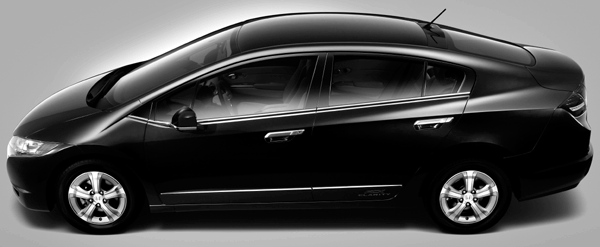
Honda FCX Clarity - Design
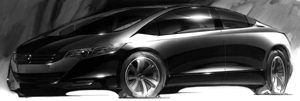
An eye-catching and futuristic design
Honda has set aside the framework of automotive design. A new and very exciting kind of vehicle has been conceived, offering a level of styling and distinctiveness that customers of premium vehicles expect.
It had to have four wheels. Beyond that, we were free.
There's no engine - this is a completely different powerplant. Free from common design constraints, the Honda team took an entirely new approach. The goal was to create a totally innovative, exciting design that suggests the future at a glance - a dynamic, full-cabin sedan featuring innovative packaging that takes advantage of the fuel cell vehicle's layout versatility and powerful driving performance.
Since the motor is so compact, Honda engineers were able to create a revolutionary new platform with a low center of gravity and a long wheelbase. The result was a new type of sedan with unique porportions and a futuristic look.
An emotional appeal that goes beyond environmental responsibility
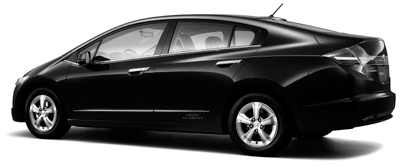 Ultimately, the appeal of a car emerges from its appearance - a sense of motion even when it's standing still. Features like the accentuated fender flares complement the dynamically tapered lines of the front and back of the cabin and the flowing side lines of the one-motion form. The innovative and attractive packaging of the FCX Clarity take it well beyond the realm of environmental responsibility.
Ultimately, the appeal of a car emerges from its appearance - a sense of motion even when it's standing still. Features like the accentuated fender flares complement the dynamically tapered lines of the front and back of the cabin and the flowing side lines of the one-motion form. The innovative and attractive packaging of the FCX Clarity take it well beyond the realm of environmental responsibility.

Environmental responsibility is looking good
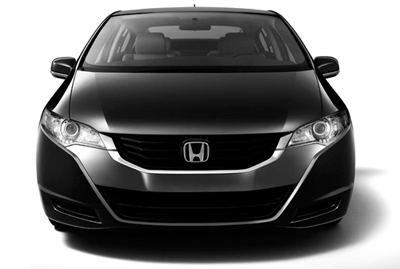
 Distinctive. Dynamic. A glimpse of the future.
Distinctive. Dynamic. A glimpse of the future.
The elegant form of the FCX Clarity sets it apart from everything else on the road and complements the rational, environmental reasons for driving a fuel cell vehicle. The sharp, dark chrome trim that runs from bumper to headlight draws the eyes toward the front fenders, creating a powerful, dynamic look and a cool, clean, futuristic feel. The side mirrors complement the FCX Clarity's free-flowing cabin. Mounted on slender arms that blend with the door molding, they emphasize the elegant lines of the side windows, with the molding embracing the mirror housing. The exterior door handles have a spare, clean look that emphasizes the slender lines of the body. Robust rear fenders reinforce the compact cabin for a bold, sculpted look. The rear glass and contoured design of the rear combination lamps emphasize the vehicle's wide, confident stance.
An extra rear window for more visibility control: looks great, enhances visibility, allows for a larger trunk
The most distinctive feature of the new one-motion design is found at the rear of the FCX Clarity. To take advantage of the high-deck design and enhance rear visibility, the car is fitted with an extra window with visibility control - a feature carefully designed to protect privacy. The rear tray is set high to ensure ample trunk volume, and windows are positioned in the upper trunk lid and in the barrier behind the rear seat to allow the driver to see into the trunk.
Visibility control lets occupants see out without passersby seeing in
A special polycarbonate layer is applied to both sides of the window to make transparency dependent on the angle of vision, protecting occupants' privacy. The result is excellent rearward visibility for the driver with a high level of privacy for the rear-seat passengers.
 Free-flowing, aerodynamic design capitalizes on the new platform's unique qualities
Free-flowing, aerodynamic design capitalizes on the new platform's unique qualities
It's no coincidence that the exterior design's key features - the front and rear fenders, the front pillars, the tapered rear cabin - also contribute to outstanding aerodynamic performance. Superb aerodynamics are built right into the free-flowing, one-motion form. And because there is no engine - and therefore no low-hanging exhaust system - the car's underbody is flatter, reducing drag.
 Lightweight aerodynamics wheels
Lightweight aerodynamics wheels
Ultra-lightweight forged aluminum 5-spoke wheels have fin-shaped plastic fairings to suppress air turbulence around the wheel, reducing weight and improving aerodynamics while adding a sporty touch.

A comfortable, spacious, futuristic environment
A new dimension in comfort for all
 Honda designers aimed to take maximum advantage of the space, creating a comfort zone with a futuristic feel. The central tunnel formed by the FC Stack neatly divides the left and right front spaces. The door linings help create an inclusive feel that sets apart the personal space of four independent seats within the spacious cabin. The floating instrument panel gives the cockpit a next-generation feel and provides the driver with new levels of functionality and visibility. The warm earth-tone colors are intended to create a soothing, natural feel.
Honda designers aimed to take maximum advantage of the space, creating a comfort zone with a futuristic feel. The central tunnel formed by the FC Stack neatly divides the left and right front spaces. The door linings help create an inclusive feel that sets apart the personal space of four independent seats within the spacious cabin. The floating instrument panel gives the cockpit a next-generation feel and provides the driver with new levels of functionality and visibility. The warm earth-tone colors are intended to create a soothing, natural feel.
Personal spaces that submerge occupants in comfort
Four distinct spaces have been created within the luxurious interior. The doors feature bold concave lines that accentuate the sense of roominess and create relaxing, personal spaces.

A floating, layered instrument panel for an advanced feel
Front pillars have been extended forward, while maintaining generous headroom proportions, to create a sense of space. The instrument panel is set off as a unified mass unconnected to the door line, making it appear to levitate. Bright coloring in the padding accentuates the airy, spacious feel.
 An advanced cockpit for a futuristic experience
An advanced cockpit for a futuristic experience
Naturally, because it's a Honda, the FCX Clarity is fun and easy to drive. The new fuel cell multi-functional display in the cockpit, for example, features three-dimensional displays of hydrogen consumption, battery levels, motor output and other key information. The speedometer is positioned directly above the display to minimize eye movement. A compact electronic shifter that leverages the latest in drive-by-wire technology has been molded into the meter visors. Other design touches enhance the futuristic feel, like the start switch beside the center console that activates the fuel cell stack.

Fuel cell performance meters
The luminescent three-dimensional meters recessed into the instrument panel display all key driving information. A centrally located ball-shaped H2 meter keeps track of hydrogen consumption. The vehicle's meters work together to provide an effective interface, providing the data output the driver needs.
The H2 ball-shaped hydrogen consumption gauge changes color and size to reflect hydrogen consumption as driving conditions change. During high consumption, the ball becomes large and amber-colored. As consumption decreases, it shrinks and turns yellow, then blue. The Hydrogen fuel and battery gauges are to the right of the H2 ball-shaped meter. The fuel cell stack output gauge and battery output/charge display are on the outer perimeter.

 Luxury from the future
Luxury from the future
Silver accents, blue acrylic in the interior door handle, and audio panel impart a futuristic look. High-quality materials like wood-grain appearance paneling in the doors and luminous black lacquer headrests combine with warm colors for a luxurious, space-age feel.
Interior Design
Comfortable, easy to use, and environmentally responsible
 Honda Bio-Fabric, a new interior fabric made from plant material - another world's first for Honda
Honda Bio-Fabric, a new interior fabric made from plant material - another world's first for Honda
To help move away from petroleum-based resins and other synthetic fibers toward plant-based fabrics, Honda created a new premium bio-fabric for vehicle interiors. Honda Bio-Fabric is a polyester material called poly(trimethylene terephthalate (PTT) made by fermenting corn Its texture and durability make it perfect for use in seat coverings, door linings, console trays and arm rests - any part of the vehicle where the occupants will appreciate its premium feel. Poly(lactic acid) (PLA) fibers made from corn and other plant biomass are used in roof linings, floor carpeting and trunk linings. In fact, all interior fabric coverings in the FCX Clarity are made of natural, plant-based materials.
Areas where Honda Bio-Fabric (PTT) is used
- Seat coverings
- Front/rear armrests
- Front/rear door linings (middle section)
- Door armrests
- Console tray
Areas where bio-fabric (PLA) is used
- Roof lining
- Pillar coverings
- Floor carpets
- Piece mats
- Trunk lining
 Honda Bio-Fabric: outstanding elasticity and feel
Honda Bio-Fabric: outstanding elasticity and feel
The molecular structure of PTT fiber is finely kinked in an accordion structure, allowing it to stretch more readily than other fibers and return easily to its original shape, avoiding sagging. It also has a unique, silky feel not found in other coverings. That's why Honda Bio-Fabric is used on all surfaces that come into direct contact with the occupants.
The production process
The 1,3-propanediol, which forms the raw material for PTT fibers, is normally produced by chemosynthesis. In contrast, Honda Bio-Fabric is made from corn using a bio-tech fermentation method. It is combined with terephtalic acid, a petroleum extract, to create PTT resin, which in turn is spun, made into fibers, dyed, and turned into Honda Bio-Fabric.
Reducing CO2 emissions
Based on the product life-cycle from procurement of raw materials to production, Honda Bio-Fabric provides a CO2 reduction of 30% per FCX Clarity automobile, compared to conventional polyester made from petroleum products. Plant-based resins are carbon neutral even when incinerated - the CO2 released during disposal is balanced by the CO2 absorbed during growth.
 Front-row independent temperature controls
Front-row independent temperature controls
To meet the expectations of premium automobile customers, the FCX Clarity is equipped with dual zone climate control to ensure optimal occupant comfort and more efficient use of energy.
Climate controlled seats
Temperature control devices built right into the seat cushions and seatbacks use fans to draw in air, which a thermo-electric device then cools (by absorbing heat) or warms. The air is then blown through the seats to maintain the desired temperature while maintaining the breathability of the urethane, permeable foam and upholstery layers. Since it provides heating and cooling in direct contact with the occupants, this process is faster and more efficient than air conditioning alone. Individual controls are conveniently located on either side of the center panel, providing an advanced touch of comfort for the luxury customer.

Ample storage space
The FCX Clarity is designed to meet every storage need. There are drink holders for each occupant and many other easy-to-use storage areas. A trunk space, separate under-trunk storage well, and other innovations add up to storage volume comparable to other mid-size sedans.
Trunk volume: 11.1 (13.1*) cubic ft
*Including under-trunk storage well
Honda calculations according to SAE formula
Honda FCX Clarity - Core Technology
V Flow FC Stack
Smaller. Higher Output. The fuel cell vehicle has evolved.
The new V Flow FC Stack is smaller and more powerful - a giant leap forward
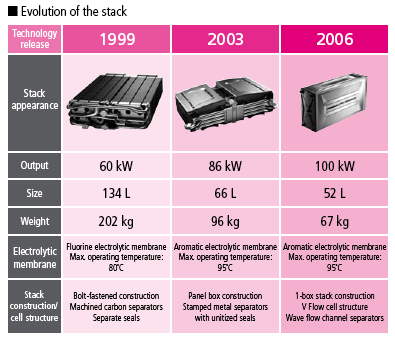 Honda fuel cell vehicles continue to lead the industry. Recognizing that the fuel cell stack is the key to the fuel cell vehicle's evolution, Honda has continued to improve performance and packaging. In 2003, Honda unveiled the Honda FC Stack, capable of sub-zero startup and with outstanding production feasibility. Its design, featuring stamped metal separators and an aromatic electrolytic membrane revolutionized the fuel cell. Next, Honda took up the challenge of structural innovation - creating the V Flow FC Stack with an original cell structure that delivers decreased weight, improved performance and even more compact design. The V Flow FC Platform is the next generation in package design. It makes compelling styling and packaging feasible in a fuel cell vehicle for the first time. It's the breakthrough in stack technology that gives the FCX Clarity its elegant design.
Honda fuel cell vehicles continue to lead the industry. Recognizing that the fuel cell stack is the key to the fuel cell vehicle's evolution, Honda has continued to improve performance and packaging. In 2003, Honda unveiled the Honda FC Stack, capable of sub-zero startup and with outstanding production feasibility. Its design, featuring stamped metal separators and an aromatic electrolytic membrane revolutionized the fuel cell. Next, Honda took up the challenge of structural innovation - creating the V Flow FC Stack with an original cell structure that delivers decreased weight, improved performance and even more compact design. The V Flow FC Platform is the next generation in package design. It makes compelling styling and packaging feasible in a fuel cell vehicle for the first time. It's the breakthrough in stack technology that gives the FCX Clarity its elegant design.

The new V Flow FC Stack: high output in a lightweight, compact design
The V Flow FC Stack features an entirely new cell structure that achieves a higher output of 100 kW, smaller size and lower weight, with a 50% improvement in output density by volume, and a 67% increase in output density by mass, compared to the 2005 FCX.

 Layers of cells producing lots of energy
Layers of cells producing lots of energy
The Honda V Flow FC Stack uses a proton exchange membrane fuel cell (PEMFC) electrical generation system that directly converts chemical energy produced in hydrogen-oxygen reactions into electrical energy. The extremely thin proton exchange membrane (electrolytic membrane) is sandwiched between pairs of electrode layers and diffusion layers (the hydrogen and oxygen electrodes) to form a membrane electrode assembly (MEA). The MEA is enclosed between two separators to form a cell - a single electrical generation unit. Several hundred cells are stacked together to form a fuel cell stack. As with batteries, these individual cells are connected in series to produce a high voltage.
How electricity is generated
- Hydrogen gas is passed over the hydrogen electrode. Each hydrogen atom is converted into a hydrogen ion in a catalytic reaction with the platinum in the electrode, releasing an electron.
- Having given up its electron, the hydrogen ion passes through the electrolytic membrane, where it joins with oxygen from the oxygen electrode and an electron arriving via an external circuit.
- The released electrons create a flow of direct current in the external circuit. The reaction at the oxygen electrode produces water as a byproduct.
- Because the electrolytic membrane must be kept continually damp, it is necessary to humidify the supply of hydrogen and oxygen. The water byproduct is recycled for this purpose. Unneeded water and air are released as exhaust.
 Electrical power on demand
Electrical power on demand
The main components of the fuel cell vehicle's power plant are the fuel cell stack, which generates electricity from hydrogen, the hydrogen tank, the lithium ion battery, the electric drive motor, and the Power Drive Unit (PDU), which governs the flow of electricity. Because the vehicle is propelled by an electric motor, it delivers smooth, powerful acceleration and quiet operation, without the noise and vibration associated with an internal combustion engine. During startup and acceleration - when a large amount of power is required - the electricity from the fuel cell stack to the drive motor is supplemented with electricity from the lithium ion battery to provide powerful performance. During deceleration, the drive motor works as a generator, converting kinetic energy into electricity, which is stored in the lithium ion battery along with any excess electricity produced by the fuel cells. When the vehicle is stationary, an idle stop system shuts down electrical generation in the fuel cell stack. Electricity from the lithium-ion battery ensures continued operation of the air conditioner and other devices. The system optimally controls electrical power, resulting in highly efficient operation.

Another key advance: a vertical gas flow cell structure is combined with wave flow-channel separators for an even more compact, lightweight design.
Until now, hydrogen and air flowed horizontally through the cells of Honda fuel cell stacks. The new V Flow FC Stack introduces a cell structure in which hydrogen and air flow vertically, and gravity is used to facilitate more efficient drainage of the water byproduct from the electrical generating layer. The result is greater stability in power generation. The new structure also allows for a thinner flow channel and reduction in the stack's size and weight. And Honda's innovative and original wave flow-channel separators provide a more even and efficient supply of hydrogen, air and coolant to the electrical generating layer. The results are higher generating performance, optimal cooling characteristics and major reductions in size and weight. More compact, the new stack has far fewer parts and can be fitted into a single box. It's also much easier to manufacture and can be fitted into a single box.


V Flow cell structure for greater stability in electrical generation and a thinner design
In addition to allowing hydrogen and air to flow vertically, the V Flow design also means that water drainage is assisted by gravity. Water doesn't collect on the electrical generation layer, ensuring constant power generation. This also allows flow channel depth to be reduced by 17% - a major contributing factor in creating thinner cells and a more compact stack.

 Wave flow-channel separators enable a smaller stack design
Wave flow-channel separators enable a smaller stack design
The fuel cell consists of a membrane electrode assembly (MEA) - an electrolytic membrane sandwiched between the pairs of electrode layers and diffusion layers forming the hydrogen and oxygen electrodes - which are in turn enclosed between separators containing flow channels for hydrogen, air and coolant. The V Flow FC Stack incorporates wave-shaped vertical flow channels for the hydrogen and air, with horizontal coolant flow channels weaving between them. The wave flow channels provide greater flow length per channel than straight channels, while the resulting turbulent flow within the channel promotes improved hydrogen and air distribution. As a result, the hydrogen and air are spread over the entire electrode layer, making more efficient use of the compact electrical generation layer and achieving approximately 10% higher generating performance than with straight flow channels. The horizontal coolant flow also ensures more even cooling over the entire electrical generation layer, allowing for a reduction in the number of cooling layers to half that of previous stacks. The previous stack had one cooling layer for each cell. The new stack needs only one cooling layers per two cells. This results in a 20% reduction in stack length and a 30% weight reduction - a major breakthrough in compact, lightweight stack design.

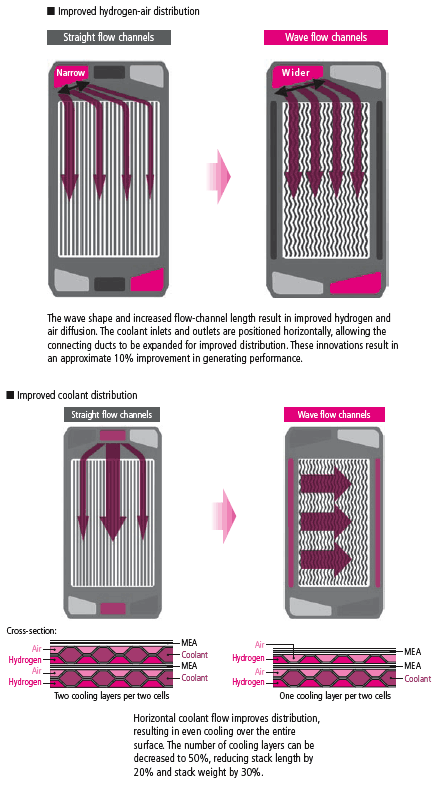
Improved heat mass allows startup at -30°C
Improved water drainage due to the V Flow cell structure facilitates better output immediately after startup. The reduced coolant volume and single-box design made possible by the wave flow-channel separators results in heat mass 40% lower than previous stacks. As a result, the amount of time required to achieve 50% output after startup at -20°C (-4°F) is only one-quarter that of the previous stack. Startup is now possible at temperatures as low as -30°C (-22°F).

Honda FCX Clarity - Packaging
Layout
Human-friendly packaging: the future of comfort.
Distributing the powerplant redefines the basic configuration of the automobile.
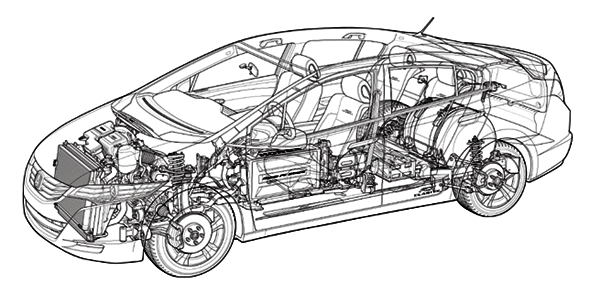
The new V Flow FC platform allows for unprecedented spaciousness. It's the next generation in human-friendly design.
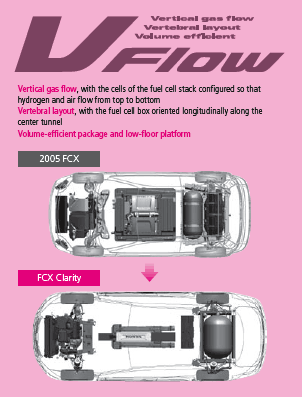
The most distinctive feature of the fuel cell vehicle - other than the fuel cell itself - is the layout flexibility made possible by the fact that the powerplant and drive train can be distributed throughout the vehicle. In order to take full advantage of this feature, each component in the powerplant must be made extremely compact. To this end, each part of the fuel cell stack - the drive motor and gearbox, the power drive unit, the lithium ion battery, and even the hydrogen tank and radiators - have been made as compact and as high-performance as possible. This creates maximum freedom to optimize the position of each part to achieve the spacious, full-cabin design unique to this new fuel cell vehicle. The end product is the embodiment of Honda's man maximum, machine minimum design philosophy - and the next generation in human-friendly automobiles.

 The V Flow FC Stack is located inside the center tunnel, and the lithium ion battery is placed under the rear seat. The result is a free-flowing, full-cabin design with a long wheelbase that provides the spacious and comfortable seating that customers expect in a luxury car.
The V Flow FC Stack is located inside the center tunnel, and the lithium ion battery is placed under the rear seat. The result is a free-flowing, full-cabin design with a long wheelbase that provides the spacious and comfortable seating that customers expect in a luxury car.
The drive motor, gearbox and PDU are combined for major space savings in the drive train system. A more compact radiator unit contributes to the short-nose design.
Reducing the number of parts in the hydrogen tank and modifying its shape result in a more efficient use of space, creating ample room in the rear seating and trunk areas. Improvements both to the hydrogen tank and the FC stack layout result in a low floor and low overall height - the car's packaging is sporty and functional.
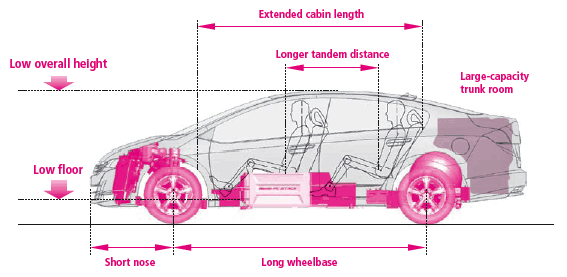
Powertrain
The technology - a powerplant that is sure to spark a revolution in design, packaging and performance
In addition to making the fuel cell stack, drive motor, and other individual components more compact, parts have been consolidated into modular units. The result is an amazingly compact and lightweight design - 397 pounds (180 kg) lighter and 45% smaller than the previous powerplant.
A significantly more compact, unified fuel cell system
The fuel cell stack is now contained in one box instead of two. This reduces the number of parts required to connect the stacks together and allows the hydrogen supply system, humidifier system, and contactors to be combined into a single unit that is 65% smaller than the previous system. This makes it possible to locate the stack in the vehicle's center tunnel rather than under the floor, achieving a low-floor, low-height body design.

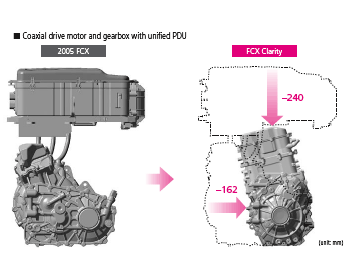 Unified coaxial drive motor/gearbox and PDU
Unified coaxial drive motor/gearbox and PDU
An innovative configuration, with drive motor and gearbox oriented coaxially, achieves a 162 mm reduction in length as measured along the drive axis. This coaxial motor/gearbox is further combined with the Power Drive Unit (PDU) in a unified configuration that saves another 240 mm in height. These innovations make possible the FCX Clarity's stylish, short-nose design.
Compact, high-efficiency lithium-ion battery requires less space
The vehicle's auxiliary power source, the new lithium-ion battery, delivers improved performance and energy recovery in a more lightweight, compact package. The new battery is 40% lighter and 50% smaller than the ultra-capacitor of the 2005 FCX, allowing it to be stowed under the rear seat. This gives the car more passenger space and a bigger trunk.

Integration of functions in hydrogen tank
Whereas the 2005 FCX carries two hydrogen tanks, the FCX Clarity has only one. This creates more space for the rear seats and trunk. The shut-off valve, regulator, pressure sensor, and other components in the refueling and supply system were integrated into a single in-tank module, reducing the number of parts by 74%. Tank capacity is greater, installation space efficiency is 24% better, and vehicle range is increased.

Three radiators integrated into one
Increased powerplant efficiency, vehicle weight reduction, and improved aerodynamics have resulted in a major reduction in heat generation. The cooling air vent for the motor bay has been reconfigured and the cooling capacity of the radiators increased. These improvements made it possible to integrate the fuel cell radiator, the drive train radiator, and the air conditioning condensor into a single three-layer unit. The new radiator unit requires 40% less space, contributing to the stylish short-nose design.

Honda FCX Clarity - Performance
A new, more advanced driving experience
A feeling that the acceleration will go on forever. Smooth, quiet and luxurious driving feel not found in any internal combustion engine-powered vehicle.
A distinctive driving experience created by the high-output electric motor
Along with uncompromising performance, the electric motor-driven FCX Clarity delivers a completely different driving sensation from a conventional vehicle powered by an internal combustion engine. There are no gear changes to interrupt power delivery and the torque characteristics are smooth, making acceleration seamless and robust. This is a key part of its distinctive, premium driving feel. There is none of the vibration that comes from reciprocating pistons. There is no combustion noise; just quiet, clean, vibration-free performance. Startup and acceleration times are comparable to that a 2.4-liter internal combustion vehicle of similar size.


The FCX Clarity's high-efficiency powerplant and outstanding energy management result in an exceedingly high operating energy efficiency of 60%. Furthermore, vehicle weight reduction and superb aerodynamics contribute to an approximate 20% improvement in fuel economy. Hydrogen tank capacity has also been increased, extending vehicle range by 30%.

 Higher output, high torque, higher rpms and quieter operation in a more compact design
Higher output, high torque, higher rpms and quieter operation in a more compact design
The new drive motor configuration was developed to deliver more powerful acceleration and a higher top speed, along with a quieter, more luxurious ride. The new rotor and stator feature a combined reluctance-torque, low-loss magnetic circuit and full-range, full-digital vector control to achieve high efficiency and high output over a wide speed range. The innovative shape and layout of the magnets in the rotor result in high-output, high-torque, high-rpm performance. These innovations deliver a maximum output of 100 kW along with impressive torque and power output density. At the same time, resonance points in the high-frequency range have been eliminated for quieter operation.
New rotor delivers high-output, high-torque, high-rpm performance
A newly designed rotor features an Interior Permanent Magnet (IPM) to lower inductance, improving reluctance torque to deliver high-torque performance. The magnet's high-energy characteristics also contribute to high torque and a more compact design. These innovations result in 50% higher output density and 20% higher torque density. The number of poles has also been reduced and the magnet made wider to better withstand stress, allowing the yoke to wrap around the outside of the IPM. A center rib has been installed for greater rigidity. This more robust construction allows for operation at higher rpm.
New stator contributes to higher torque and higher efficiency
The stator features a low iron-loss electrical steel sheet and
higher density windings that decrease resistance and contribute to high torque and higher output.
Number of poles reduced to eliminate resonance points and produce quieter operation
The number of magnetic poles in the rotor has been reduced from 12 to 8, eliminating resonance points within the operating rpm range. The result is outstanding quietness and higher output.

 Coaxial gearbox conveys motor output directly for a major improvement in compact design
Coaxial gearbox conveys motor output directly for a major improvement in compact design
The rotor shaft in the motor features a hollow construction, with the driveshaft passing through its center in a coaxial configuration. This arrangement, unique to electric vehicles, allows the motor and gearbox to be combined into a single, compact unit, while providing highly efficient transmission of the motor's high-output, high-rpm power to the driveshaft. Innovative bearing design and fewer rotor oil seals result in lower friction for higher transmission efficiency, creating driving performance with a more direct feel.
 Easy-to-use Shift-By-Wire for simpler operation
Easy-to-use Shift-By-Wire for simpler operation
The vehicle's fixed gear ratio allows for simple operation: there's an easy-to-use shift control for forward, reverse and park that has a light touch and a short stroke. The compact shift unit features electronic control, allowing the shift lever to be installed on the dashboard. The shifter, start switch and parking switch are all easy to operate. Other operating systems are also laid out in separate zones to improve ergonomics.
Power assist and efficient regeneration with an advanced lithium-ion battery
The compact, high-output lithium-ion battery assists the fuel cell in powering the vehicle. The advanced battery provides a powerful supplement to the fuel cell stack's output, powering the motor for torquey off-the-line acceleration. In addition to increasing the total energy capacity, the battery efficiently stores energy generated by the intelligent regenerative braking system, capturing 11% more kinetic energy than the ultra-capacitor used in the 2005 FCX. Some 57% of the energy of deceleration is regenerated with the new system.
Enhanced regeneration for reduced brake operation in downhill driving
As a result of increased energy storage capacity and a broader range of regeneration control, it has been possible to implement a system that regulates acceleration and reduces the need for pedal operation in downhill driving. Assessing incline and vehicle speed, the system regulates acceleration when the driver first releases the accelerator pedal, minimizing the need for frequent braking. The system simultaneously adjusts the amount of regenerative braking to help maintain constant vehicle speed after brake pedal inputs. The function is similar to engine braking in an gasoline-engine powered vehicle, but more intelligent, smoother, and easier to use.

 Superior chassis dynamics for greater comfort, safety, and driving pleasure
Superior chassis dynamics for greater comfort, safety, and driving pleasure
With double-wishbone at the front and 5-link double-wishbone at the rear, the suspension delivers smooth handling and an even ride.
Optimal geometry front and back, including carefully calibrated toe response to the suspension stroke and camber angle maximize tire contact with the road during cornering for highly responsive, stable handling. Optimization of the anti-dive angle and control of vehicle behavior during deceleration contribute to an even, comfortable ride. The lowered front suspension adds to the visual impact of the short-nose design. In addition to the implementation of a 5-link double wishbone rear suspension, forged aluminum lower arms and high-capacity trailing arm bushings and reduced unsprung weight, smoothing out bumps in the road.
Responsive electric power steering for a 17.7-foot turning radius and tight cornering
Along with a newly implemented brushless motor for increased output, the front double wishbone suspension helps facilitate tight cornering and delivers a 17.7-foot turning radius - a very tight turning radius given the the vehicle's long wheelbase. The low inertia of the motor and minimal friction of the suspension in turning contribute to smoother steering. And a tilt & telescopic steering wheel provide an optimal steering position for drivers of all physiques.
 Vehicle Stability Assist (VSA) integrated with electric power steering (EPS) for enhanced handling
Vehicle Stability Assist (VSA) integrated with electric power steering (EPS) for enhanced handling
The FCX Clarity features an integrated braking, traction control and electric-controlled steering system that works in concert to help the driver maintain control of the vehicle in emergency maneuvers and in varying road conditions. Working in conjunction with the vehicle's anti-lock brakes, Traction Control System (TCS) with slideslip control, and Vehicle Stability Assist (VSA), the Electric Power Steering (EPS) enhances steering force for even better handling.
- In controlling understeer, EPS provides supplementary steering force to prevent the steering wheel from being turned too far as motor torque is reduced and as braking force is applied to the inner rear wheel by the VSA.
- In controlling oversteer, the EPS provides steering force to help the driver counter the spin-generating moment as braking is applied to the outer front wheel to stabilize the vehicle.
- When road conditions under the left and right tires are different, torque and steering force are supplemented to help the driver maintain stability.
Complementing the linear torque control of the drive motor, the TCS provides enhanced grip and control in acceleration
Increased motor torque responsiveness during TCS operation has made a major contribution to suppressing excessive tire slip. Improvements to the total system deliver even more precise torque transmission and improved grip for confident acceleration even on slippery surfaces, and improved control in acceleration.
Adaptive Cruise Control is standard equipment.
Honda FCX Clarity - Safety
Protecting occupants and pedestrians; and the proper handling of hydrogen
Striving to protect vehicle occupants
To enhance occupant crash protection, Honda has implemented innovative body technology with a network of frame structures in the front of the vehicle along with additional safety precautions appropriate to a fuel cell vehicle. The vehicle complies with government collision safety standards, including for full frontal collisions up to 35 mph, MBD side-impact collisions up to 33.5 mph, pole-side impact collisions up to 18 mph, and rear-offset collisions up to 50 mph. The fuel cell system and hydrogen tank are protected from collisions at every angle.

A body designed for the V Flow platform with the rigidity to withstand collisions from all angles
Taking full advantage of the distributed powerplant layout, we've optimized the body structure. To help protect occupants in the event of frontal collisions, the straight front side frame, upper frame, and lower structural parts are designed to disperse and absorb impact energy. Energy is dispersed through the front pillars and floor. The lower structural members are designed to help prevent misalignment with the impact-absorbing parts of the other vehicle. Along with an energy-absorbing upper frame, they efficiently disperse energy over a wider area. This design is intended to both reduce the impact forces on FCX Clarity occupants as well as on the other vehicle. The enhanced rigidity of the body also helps provides a premium level of comfort for all occupants.
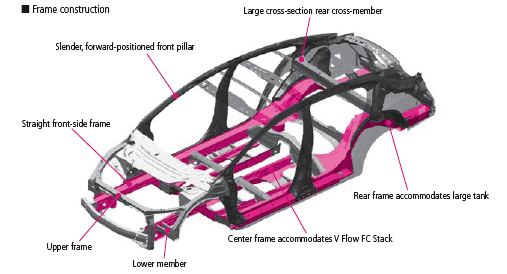
The impact-absorbing front-end design helps enhance pedestrian protection
To help protect pedestrians, we've designed the FCX Clarity's fenders, hood hinges, wiper pivots, and other components to more efficiently absorb collision impact.
Braking and seat belt control help protect occupants against injuries from rear-end collisions, while the Collision Mitigation Brake System and seatbelt Automatic Tensioning System provide enhanced safety for the driver and front passenger.
Advanced safety technology protects occupants
- Side-curtain airbag system
- Driver and front passenger SRS airbags
- Active front seat head restraints
- Driver and front passenger seat belt reminders
- Side airbag system
- Impact-absorbing interior
- Three-point, load-limiting, automatic tensioning system-equipped ELR seat belts for driver and front passenger
Safety measures for handling hydrogen and high-voltage electricity
Sensors are located throughout the vehicle to provide a warning in the unlikely event of a hydrogen leak. Should such a leak occur, a ventilation system is activated and an automatic system closes the main cut-off valves on the hydrogen tanks or supply lines as necessary. The high-voltage lines are electrically isolated. Sensors provide a warning in case of grounding. In the event of a collision, high-voltage contactors shut down the source power line. Repeated flood and fire testing have confirmed a very high level of safety and reliability.

Hydrogen refueling safety measures
To prevent reverse flow from the tank, the hydrogen filler inlet has an integrated check valve. The fuel intake mechanism is also designed to prevent contamination by other gases or the connection of nozzles designed for hydrogen stored at incompatible pressure levels.

Honda FCX Clarity - Main Specifications
| Model type | Honda fuel cell vehicle | ||
| Name | FCX Clarity | ||
| Dimensions, weight, occupancy |
Overall length (inches) | 190.3 | |
| Overall width (inches) | 72.7 | ||
| Overall height (inches) | 57.8 | ||
| Wheelbase (inches) | 110.2 | ||
| Tread (front/rear, inches) | 62.2/62.8 | ||
| Vehicle weight (pounds [kg]) | 3,582 [1,625] | ||
| Number of occupants | 4 | ||
| Performance | Maximum speed (mph) | 100 | |
| Vehicle range, previous EPA approved method (miles)* | 270 | ||
| Powertrain | Drive method | Front-wheel drive | |
| Motor | Type | AC synchronous electric motor (permanent magnet) | |
| Max. output (kW [HP]) | 100 [134] | ||
| Max. torque (N·m [kg·m]) | 256 [26.1] | ||
| Fuel cell stack | Type | PEMFC (Proton Exchange Membrane Fuel Cell) | |
| Max. output (kW)* | 100 | ||
| Lithium-ion battery | Voltage (V)* | 288 | |
| Fuel | Type | Compressed hydrogen gas | |
| Storage | High-pressure hydrogen tank | ||
| Tank capacity (L) | 171 | ||
| Max. pressure when full (MPa) | 35 | ||
- Specifications subject to change prior to production
- Preliminary EPA mileage estimates determined by Honda. Final EPA mileage estimates not available at the time of printing. Use for comparison purposes only. Mileage will vary depending on how the vehicle is driven.
- Specifications are determined in accordance with procedures proscribed in Road Transportation Motor Vehicle Law, except where marked by an asterisk (*) indicating Honda test values.
- FCX, Clarity, Honda FC Stack, V Flow FC Platform, InterNavi System, and VSA are registered trademarks of Honda Motor Co., Ltd.
- Manufacturer: Honda Motor Co., Ltd.
Honda FCX Clarity - Main Specifications
| Model type | Honda fuel cell vehicle | ||
| Name | FCX Clarity | ||
| Dimensions, weight, occupancy |
Overall length (inches) | 190.3 | |
| Overall width (inches) | 72.7 | ||
| Overall height (inches) | 57.8 | ||
| Wheelbase (inches) | 110.2 | ||
| Tread (front/rear, inches) | 62.2/62.8 | ||
| Vehicle weight (pounds [kg]) | 3,582 [1,625] | ||
| Number of occupants | 4 | ||
| Performance | Maximum speed (mph) | 100 | |
| Vehicle range, previous EPA approved method (miles)* | 270 | ||
| Powertrain | Drive method | Front-wheel drive | |
| Motor | Type | AC synchronous electric motor (permanent magnet) | |
| Max. output (kW [HP]) | 100 [134] | ||
| Max. torque (N·m [kg·m]) | 256 [26.1] | ||
| Fuel cell stack | Type | PEMFC (Proton Exchange Membrane Fuel Cell) | |
| Max. output (kW)* | 100 | ||
| Lithium-ion battery | Voltage (V)* | 288 | |
| Fuel | Type | Compressed hydrogen gas | |
| Storage | High-pressure hydrogen tank | ||
| Tank capacity (L) | 171 | ||
| Max. pressure when full (MPa) | 35 | ||
- Specifications subject to change prior to production
- Preliminary EPA mileage estimates determined by Honda. Final EPA mileage estimates not available at the time of printing. Use for comparison purposes only. Mileage will vary depending on how the vehicle is driven.
- Specifications are determined in accordance with procedures proscribed in Road Transportation Motor Vehicle Law, except where marked by an asterisk (*) indicating Honda test values.
- FCX, Clarity, Honda FC Stack, V Flow FC Platform, InterNavi System, and VSA are registered trademarks of Honda Motor Co., Ltd.
- Manufacturer: Honda Motor Co., Ltd.
































































